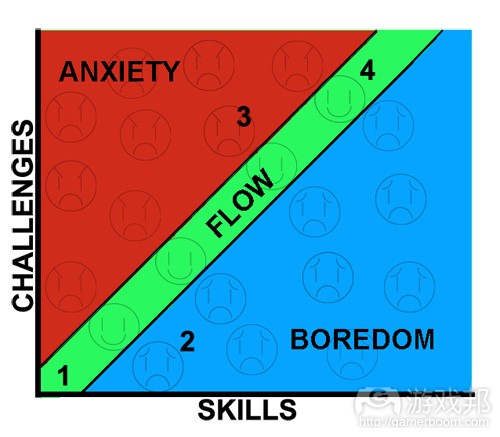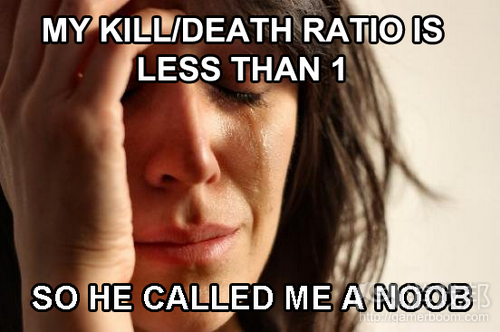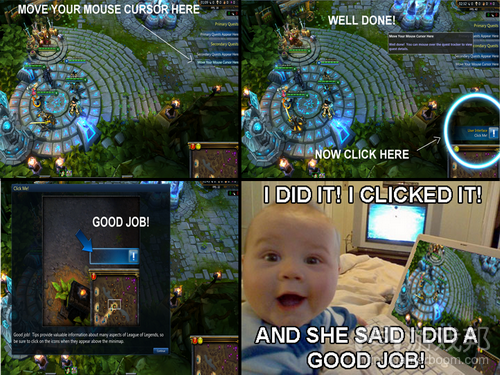以心流状态分析游戏指南的挑战性&趣味性
作者:Cary Chichester
指南通常是游戏体验的必要组成要素,但毫无疑问,当你教授很多需要耗费较长时间掌握的机制时,玩家的学习过程就不那么有趣。指南的挑战之处在于要确保体验趣味横生,同时又要训练玩家。
单人指南通常更容易变成有趣的体验。玩家会同AI进行持续若干小时的角逐,因此设计师通常都慢慢训练玩家,因为指南内容完全融入体验中。但在多人体验中,玩家通常和其他对手而非AI进行较量,所以指南是个独立内容,训练竞赛,而非实际比赛将促使玩家丧失潜在乐趣。
上图是Csikszentmihalyi的心流图表。置身心流状态的必要条件是玩家需掌握应对关卡挑战的相应技能。掌握过少技能会令他们焦躁不安,而掌握过多技能则会促使体验变得乏味。各数据代表玩家在普通多人游戏中的自然发展阶段。
1. 玩家刚开始玩游戏。他们的技能水平多半很低,所以他们给自己设定的挑战多半也很低。他们不会想要尝试赢得比赛,而是会首先要求自己学习若干新移动操作及攻击些许敌人。由于低挑战同他们的低技能相呼应,因此他们处于心流区域。随着他们掌握更多游戏内容及其中挑战,他们发现自己的技能不足以应对这些挑战,因此开始脱离心流状态。
2. 玩家发现自己不知道要如何体验及完成指南内容,让自己的技能更好匹配挑战内容。体验通常缺乏趣味性,所以他们最终会心生厌烦,想知道自己什么时候能够同他人共同体验。在他们真正同他人共同体验游戏的完整内容前,出现乏味感将无法避免。
3. 无论玩家在首场比赛前收到多少信息,在同进行过更多比赛回合(游戏邦注:即便只是多几场)的玩家进行较量时,他们依然属于新手玩家。当玩家不熟悉地图布局及最佳策略,进而被熟悉这些内容的人士嘲笑时,出现焦虑感在所难免。
4. 进行几个回合的比赛后,玩家起初的紧张感会消失,因为他们开始变得更杰出。当他们的技能逐步提高,能够应对其他玩家呈现的挑战时,他们又再次开始经历心流状态。
在紧张和厌烦状态之间,厌烦情绪对游戏而言更加有害,因为最佳体验通常令人愉快且趣味横生。焦虑不可避免,因为多数玩家会在首个游戏回合中紧张不安,所以厌烦情绪是更容易解决的问题。为降低指南带来的厌烦情绪,许多指南内容都极力保持简洁性,附带加载页面提示,呈现指南没有覆盖的其他经验内容;这有可能会导致未向玩家传递足够信息,进而提高他们的体验焦虑感,因为他们没有做好充分准备。焦虑感提升不仅是因为他们缺乏技能,还因为社区玩家将因此笑话他们。
巧妙给指南添加更多心流元素的一个方式是,让他们融入AI bots,以提高玩家学习机制的挑战性。这让玩家得以参与引导他们把握游戏规则和机制的实践竞赛。这通常是个受到仔细引导、挑战性很低的练习(游戏邦注:依然有些许粘性),它们不够有趣,玩家多半不会想要再次进行体验。玩家完成指南内容后,教育玩家的主要目标就顺利完成,玩家的技能远超越游戏呈现的少量挑战,所以在着手开始进行竞争性比赛前,玩家没有欲望停留在指南内容中。如果旁白以谦卑方式祝贺他们顺利掌握简单指令,他们会更迫不及待地想要终止指南内容。
制作指南是因为它们是玩家需要的内容,但我们还应该将其打造成玩家期望获得的内容。如果这不是他们想要获得的内容,那他们就不会喜欢这些内容。如果他们想要获得挑战和竞争,为什么不在指南中积极融入这些元素?我在近来的《Sonic》游戏中体验最多的关卡是游戏的首个关卡。在1分钟内完成关卡(这需要探索关卡及掌握控制装置,两种技能都需要玩家反复试验关卡,方能最终掌握),玩家将获得成就奖励。
获得成就奖励后,我依然继续进行尝试,希望能够缩短时间,在排行榜上获得更靠前的位置。我并不觉得这款游戏属于竞争性质,但我在首个关卡就开始积极展开角逐,希望能够获得炫耀权利。我觉得自己已差不多掌握这款游戏,而此时我还没有进入第二个关卡。还有若干方式能够提高指南的挑战性:可以选择像《Sonic》那样融入动态难度:同个关卡会带给勇敢玩家各种各样的挑战;再来就是静态关卡:玩家会选择他们偏好的挑战层级;或者甚至是即时竞争:玩家在指南关卡同其他玩家展开竞争。最后一种情况也许带来些许紧张情绪,但如果他们急于想要体验竞赛内容,那么不记录数据的竞赛角逐无疑最适合他们。
制作指南绝非易事;在不令玩家心生厌倦的情况下向他们传递所有必要信息是项困难任务。这不是独立于游戏之外的体验;它们是游戏的组成部分,需富有趣味。玩家会在头30分钟的体验里就对游戏形成总体印象,所以最好确保他们在这段时间里享受于游戏当中。(本文为游戏邦/gamerboom.com编译,拒绝任何不保留版权的转载,如需转载请联系:游戏邦)
Creating Enjoyable Tutorials Using Flow
by Cary Chichester
Tutorials are an often necessary part of playing a game, but there’s no doubt that when you have a lot of mechanics to teach that require a lot of time to learn, the player’s experience with learning them is often not very fun. The challenge with tutorials is making the experience fun while simultaneously educating the player.
Single-player tutorials are usually easier to turn into fun experiences. The player expects to play against A.I. opponents in an experience that will last several hours, so the designer has seemingly all the time in the world to slowly train them as the tutorial is integrated in the experience. In a multiplayer experience however, players expect to play against other opponents instead of A.I ones, so the tutorial is a separate entity where every minute spent in a training match instead of a live match is time taken away from the player’s potential enjoyment.
Displayed above is a representation of Csikszentmihalyi’s flow graph, which shows that the requirements for being in the flow area is for a player to have the skills that correspond to the level of challenge they face. Having too little skill will stress them out while having too much will make the experience boring. Each number represents a stage during the natural progression of a player for an average multiplayer game.
1. The player just started playing the game. Their skill is probably low, so the challenge they set for themselves is probably low as well. Rather than attempt to win a match, they’ll first task themselves with learning some new moves and attacking a few enemies. Because the low challenge corresponds to their low skill, they enter flow. As they learn more about the game and the challenges with mastering it, they see that their skill is not yet ready for that challenge and then exit flow.
2. At some point the player realizes they have no idea how to play and goes through the tutorial so that their skill will better match their challenges. The experience isn’t usually very fun, so they just end up being bored and wondering when they’ll get to play with other people. Until they get to experience the full game with others, there will be an unavoidable feeling of boredom.
3. Regardless of how much information the player receives before their first match, they will still be a brand new player in a match with others that likely have played more matches—even if only a few more. When your player is unfamiliar with map layouts and optimal tactics while being judged by those who are, there will be an unavoidable feeling of anxiety.
4. After a few matches the player will lose a lot of their initial anxiety as they start to get better. When their abilities improve and they are better able to confront the challenges presented from other players, they will start to experience flow again.
Between anxiety and boredom, boredom is seen as the more detrimental experience to a game because the optimal experience is often intended to be exhilarating fun. Anxiety can be seen as unavoidable because most players are nervous during their first match, so boredom appears to be the easier problem to tackle. To reduce the boredom that tutorials are blamed with creating, many tutorials are designed to be a short as possible with loading screen tips bearing responsibility for any lessons they didn’t cover; this carries the risk however of not conveying enough information to the player and consequently increasing their anxiety when they play because they were not properly prepared. Adding to their anxiety is not only their lack of skills, but the community of gamers that are ready to judge them for it.
One popular approach that nicely adds more flow to tutorials is having them include A.I. bots to add challenge while the player learns the system. This allows the player to participate in a practice match that guides the player through the game rules and mechanics. This is usually a heavily guided and minimally challenging exercise that—while still slightly engaging—is usually not entertaining enough for the player to want to revisit. Once the player completes the tutorial, the main goal of educating the player has been completed and the player’s skill has exceeded the small amount of challenge offered, so there’s really no desire to stay in the tutorial before rushing away to start a competitive match. They’ll be in an even greater hurry to end the tutorial if the announcer speaks to them in a condescending manner by congratulating their ability to grasp simple instructions.
Tutorials are created because they are something the player needs, but we should remember to also make it something that the player wants. If it’s not something they want, they won’t like it. If they want challenge and competition, why not find some way of including that in a tutorial? By far the level I’ve played the most in recent Sonic games has been the first one. There’s an achievement for beating it in under a minute which requires exploration of the level and mastery of the controls, both skills that require quite a few attempts at the level to achieve.
Even after I had gotten the achievement I still kept running through it to improve my time and get a higher spot on the leaderboards. I didn’t even see this game as competitive and yet there I was competing and trying to get bragging rights for—of all things—the first level! I felt like I had pretty much mastered the game, and I hadn’t even gotten to level two. There are a few ways of adding challenge to tutorials: there’s the option for dynamic difficulty like in the Sonic example where the same level has a myriad of challenges for daring players, static difficulty where the player selects their preferred level of challenge, or even real-time competition where the player competes with another player in the tutorial level. That last example may add a little anxiety, but if they’re in such a hurry to play a match, then a match against another new player where stats aren’t recorded is probably ideal for them.
Tutorials are not easy to create; conveying all the necessary information to the player without boring them is a difficult endeavor. They are not however an experience that is separate to the game itself; they are a part of the game and they need to be fun. The player will likely have a good opinion of the game formed within the first thirty minutes of playing, they better be having fun during that time!(Source:gamasutra)










































 闽公网安备35020302001549号
闽公网安备35020302001549号